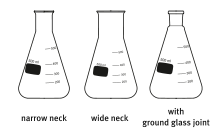- Erlenmeyer flask
-
An Erlenmeyer, also known as a conical flask, is a widely used type of laboratory flask which features a flat bottom, a conical body, and a cylindrical neck. [1] It is named after the German chemist Emil Erlenmeyer, who created it in 1861. [2] [3]
The Erlenmeyer is usually marked on the side (graduated) to indicate the approximate volume of contents, and has a spot of ground glass or enamel where it can be labeled with a pencil. It differs from the beaker in its tapered body and narrow neck. [4]
The opening usually has a slight rounded lip so that the Erlenmeyer can be easily stoppered using a piece of cotton wool, rubber bung or similar. Alternatively, the neck may be fitted with a female ground glass joint to accept a glass stopper. The conical shape allows the contents to be swirled or stirred during an experiment, either by hand or by a shaker; the narrow neck keeps the contents from spilling out. The small neck reduces evaporative losses compared to a beaker, while the flat bottom of the conical flask makes it unlikely to tip over and spill.
Contents
Uses
Erlenmeyers are used in chemistry labs for titration, e.g. for pH, as they can be held and the contents mixed single-handed leaving the other hand free to add reagent. [5]
Erlenmeyer flasks are suitable for heating liquids, e.g. with a Bunsen burner. The flask is usually placed on a ring held to a ring stand by means of a ring clamp. A wire gauze mesh or pad is usually placed between the ring and the flask to prevent the flames from directly touching the glass in the same manner as for a beaker. When heating (or cooling) in a water bath the flask can be clamped by the neck to a stand or a hooped weight may be placed over the conical part of the flask to prevent it from floating in the bath. [6]
Erlenmeyers are also used in microbiology for the preparation of microbial cultures. Plastic Erlenmeyer flasks used in cell culture are pre-sterilized and feature closures and vented closures to enhance gas exchange during incubation and shaking.
See also
- Fleaker
- Erlenmeyer flask deformity of bone
External links
References
- ^ "Flasks, Erlenmeyer Conical Flask with Plain Neck, Flask Volumetric, Flask Volumetric Measuring JSGW with Interchangeable Stopper, Accuracy as per Classes B, Flasks Boiling, Flat Bottom JSGW." IndiaMART - Indian Manufacturers Suppliers Exporters Directory,India B2B Exporter Manufacturer. Web. 17 Nov. 2011. <http://www.indiamart.com/jainscientific/flasks.html>.
- ^ Erlenmeyer Flask. Web. 17 Nov. 2011. <http://erlenmeyerflask.net/>.
- ^ "Erlenmeyer Flask | Erlenmeyer Flask." Erlenmeyer Flask|Graduated Cylinder|Triple Beam Balance|Petri Dish|Lab Bench. Web. 17 Nov. 2011. <http://erlenmeyerflask.org/erlenmeyer-flask/>.
- ^ "Laboratory Glassware,Double Distillation Apparatus,Quartz Distillation Apparatus,Laboratory Condensers,Double Water Still System,Water Still System." Laboratory Glass Equipment,Borosilicate Glass Equipment,Laboratory Glass Equipment Manufacturer,Borosilicate Glass Equipment Manufacturer. Web. 17 Nov. 2011. <http://www.ssgwlab.com/laboratory-glassware.html>.
- ^ "Erlenmeyer Flask." The Titi Tudorancea Learning Center, English Edition. Web. 17 Nov. 2011. <http://www.tititudorancea.org/z/erlenmeyer_flask.htm>.
- ^ https://eee.uci.edu/programs/gchem/RDGvolflaskpipet.pdf
Categories:
Wikimedia Foundation. 2010.




